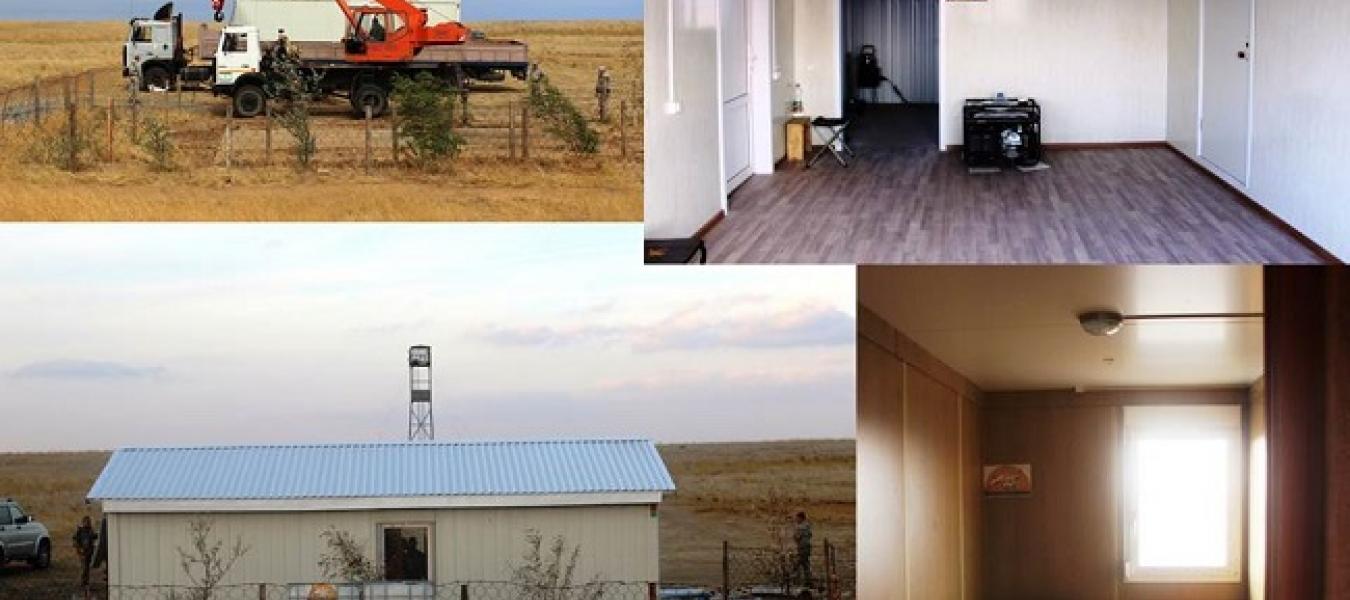
First Ranger Station for the Stepnoi Sanctuary
Having once numbered hundreds of thousands of animals, the pre-Caspian saiga antelope population has dropped rapidly due to heavy poaching. In 2012 it was at 12,000 individuals, but since then poaching has intensified across the region. The population is now down to perhaps only 3,000 animals.
A recent study by the SCA (in 2014) estimated that 34% of households in this region had eaten saiga meat in the previous 12 months; a rate which is clearly unsustainable. The only effective protection offered for this population is the Stepnoi Sanctuary.
Why the Stepnoi Sanctuary is important
The Stepnoi Sanctuary is truly the last bastion against extinction for this embattled population of the saiga, when they enter its borders we know the rangers will do everything they can to protect the remaining herds. And, due to the diligent efforts of the Stepnoi rangers both individual animals and large herds of saiga (in total up to 2,000) can be seen depending on the time of year and weather conditions. Because there are only five populations of saigas in the world (one of which is a different sub-species, found in Mongolia) it is absolutely vital to the future of the species that every one of these populations remains viable.
The Stepnoi Sanctuary is a vast reserve to patrol, covering over 119 thousand hectares, yet with no roads or ranger stations. It is a harsh environment to work in and temperatures can reach over 40 degrees celcius in the summer months and drop to -40 degrees in the winter. Up to now, the ranger teams of 10 men, who patrol the reserve 24 hours a day for two weeks at a time, have had no fixed base. The teams have had to camp out during the summer and sleep in their mini-vans with their motorbikes and other equipment during the winter months. This has hampered their ability to do their jobs, sapped morale, and reduced the respect of the local farmers, who are potential allies against poaching.
Funding for Stepnoi rangers
Funds raised through WCN's appeal, in addition to those raised from the Disney rapid response fund has allowed the SCA to support the critical work of the Stepnoi Nature Sanctuary rangers by providing them with a permanent base within the reserve. The rangers were able to buy and install a porta cabin which will serve as a 'Ranger Station' in the heart of the reserve. Once in situ they were able to modify the cabin to their specific needs, installing windows and a secure door. They insulated it from the cold and heat, installed a heating system, electricity and furnished it.
Crucially, all the work was completed prior to the saiga's rutting season and before the arrival of winter, so that it was ready in time for one of the saiga's most vulnerable periods, which the poachers take full advantage of. The cabin is now operational, creating a space in which rangers can sleep, cook, wash, relax, take shelter from the extremes of temperature, hold meetings with their wider group as well as put on seminars and receive visitors.
Already, this new ranger station is improving the effectiveness of the rangers as it allows them to be ever present in the central part of the reserve to deter poachers. Its location allows them to cover far more terrain and reach isolated areas of the reserve on a daily basis than was previously possible. Their response time to attend and apprehend poachers will also be drastically reduced due to the station's central location.
The ability to sleep in the station and take shelter from the weather has not only boosted morale amongst the rangers, but will ensure that they are able to function to the best of their abilities each time they undertake often dangerous and challenging anti-poaching patrols. The installation of the station has also raised the profile of the rangers and their work within the region, sending a clear message to the local communities, potential poachers and farmers in the reserve that the teams are taking the issue of wildlife protection very seriously, and that illegal activity will not go unnoticed and will be prosecuted.
In addition, this funding has enabled the SCA to equip the rangers with essential clothing and accessories which will make them safer, more effective and efficient. New helmets, specialist trousers, jackets and gloves will not only help insulate them from the elements but will offer them protection too. Poachers come into the reserve on high-speed cross-country motorbikes, and it is extremely dangerous to chase them; a few years ago one member of the Stepnoi ranger team was seriously injured doing this. The rangers have also been given several sets of binoculars and four sets of night vision goggles.
Future plans for the Stepnoi ranger station
In the long-term the rangers are looking forward to using their new station as a hub to receive visiting NGOs and researchers who are keen to study saigas, and other threatened steppe flora and fauna. They are also planning on using the station as an education centre, and will be holding seminars and lectures there for local school children as well as adults.
The rangers are also keen to make the station available for environment-themed activities such as photography and wildlife watching, and already have interest from a travel agency which would like to provide saiga-based tours to the region, hence raising awareness of the reserve and the important work they do to visitors from outside the region and overseas.
